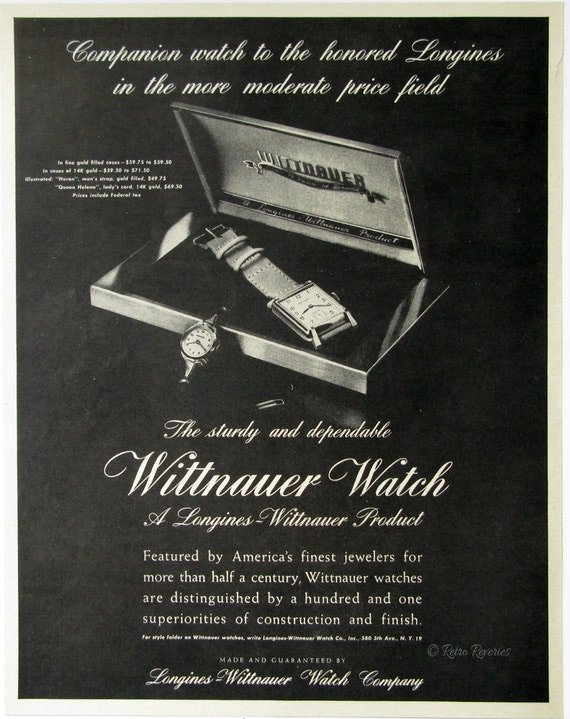Wittnauer: The Unsung Hero of North American Watchmaking
In the grand hall of vintage watches, Wittnauer is the hero of North American watchmaking—a brand deeply woven into the fabric of exploration, aviation, and even space travel. It’s the unsung champion with a Swiss connection, a name that should stand shoulder to shoulder with horology’s greats but somehow remains in the shadows. If you know, you know. If you don’t, well, let’s fix that.
The Humble Beginnings of a Timekeeping Titan
Like all great watch stories, this one starts with an ambitious immigrant. In 1872, a 16-year-old Swiss boy named Albert Wittnauer arrived in New York with a vision: to craft high-quality watches that could stand up to the grit and grind of American life. The Swiss were already synonymous with precision timekeeping, but Albert saw an opportunity—watches tailored for the adventurous, the scientific, and the downright daring. And so, Wittnauer was born.
Albert didn’t start out manufacturing watches right away. Instead, he worked with his brother-in-law, Eugene Robert, who was a distributor of fine Swiss watches—including Longines. Through this experience, Albert saw a gap in the market: Swiss watches were elegant and precise, but many were designed with European sensibilities in mind. He wanted to create an American brand—one that combined Swiss craftsmanship with durability and affordability suited for the fast-growing U.S. market. Wittnauer watches were designed to be reliable, robust, and accessible to the professionals, explorers, and military personnel who needed them most.
For years, the brand supplied precision instruments to aviators, explorers, and the military. If you needed a watch that could survive high altitudes, deep dives, or brutal expeditions, you reached for a Wittnauer. It was the quiet backbone of American timekeeping, overshadowed by flashier competitors but respected where it counted.
Enter the First Lady of Watches
Long before boardrooms were filled with power suits, Martha Wittnauer took the reins of the company in 1916—making her the first female executive in the watch industry. A pioneer, a visionary, and probably the most unbothered woman of her era, she didn’t just keep the company afloat; she pushed it forward. Under her leadership, Wittnauer continued to cement its reputation for precision, becoming the go-to brand for aviators, scientists, and even early radio broadcasters who relied on split-second accuracy.
Wittnauer: The Forrest Gump of Watchmaking
Wittnauer wasn’t just a watch company—it was everywhere, quietly playing a role in some of history’s biggest moments. Its watches were standard issue for the U.S. military during both World Wars, relied upon for their durability and precision. The company also dabbled in non-watch inventions, producing timing devices and precision instruments that found their way into laboratories, broadcasting stations, and even early aviation experiments.
Then there’s the space connection. While Omega famously got the NASA contract, Wittnauer was one of the contenders, undergoing rigorous testing for potential use in space missions. Though it ultimately lost out, Wittnauer watches proved their mettle in extreme conditions, further solidifying the brand’s legacy in precision timekeeping.
The Longines Connection (and the Eventual Takeover)
By the mid-20th century, Wittnauer had an established relationship with the Swiss powerhouse Longines, acting as its U.S. distributor. The two brands were like cousins—related but distinct, each with its own loyal following. Then, in 1950, Longines officially acquired Wittnauer, creating Longines-Wittnauer Watch Company.
For a while, this pairing worked beautifully. Longines continued producing high-end pieces, while Wittnauer became the more accessible (but still exceptionally well-made) option. But as the quartz crisis of the 1970s hit, the brand began to lose its footing. Ownership changed hands multiple times, eventually landing with Bulova in 2001, where it remains today—a shadow of its former self, but still carrying whispers of its once-great legacy.
Why is Wittnauer So Undervalued Today?
Here’s the thing: Wittnauer should be a bigger deal. Its watches have history, craftsmanship, and legitimate horological street cred. But the brand lacks the feverish collector hype of Omega or the status flex of Rolex. It’s a name that’s been passed around in corporate buyouts, losing some of its original prestige along the way.
That’s bad for the brand—but great for you. Because while collectors chase after the usual suspects, you can scoop up a vintage Wittnauer for a fraction of the price of a comparable Longines. They’re sleeper hits, quietly waiting to be rediscovered by those who appreciate the understated, the overlooked, and the truly special.
So, the next time you come across a vintage Wittnauer, don’t dismiss it. Give it a second look. It might just be the best-kept secret in your collection.




